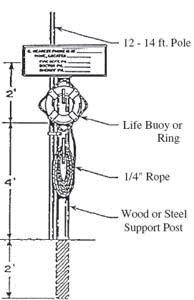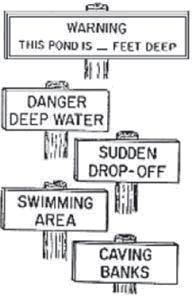| |
Three Steps to Safe Farming
When thinking about farm safety, it helps to consider it a three-step process that starts when you know the job. Knowing the job means getting properly trained ahead of time for each new task you perform. Next, know the hazard – think about the risks associated with each job, and stay alert for them at all times. Finally, know the drill – learn to safely handle the hazards you identify, either by managing them or avoiding them altogether.
Take Water Safety Seriously
Maybe you’ve always been aware of the dugout as a drowning hazard, or maybe it’s never been considered an issue. Nevertheless, drownings occur three times as often in rural areas as in urban areas. Many of these tragedies happen on farms just like yours, in ponds or sloughs. Many involve children whose natural inquisitiveness draws them to water – whether it’s a puddle, garden pond, bucket or paddling pool.
In fact, in a 10 year period between 1996 and 2006, 12 children drowned on Alberta farms. Estimates suggest that for each childhood drowning death, approximately four more children are hospitalized for near-drowning.
While drownings often happen in larger water bodies, they can also happen in much smaller hazards – such as a ditch, puddle or a rain barrel. The key to drowning prevention is to learn about water safety and then apply your knowledge to prevent a tragedy in your own farmyard. Know the job.
Be Aware of Water Hazards
Adults who drown on farms seldom recognize the situation as hazardous before tragedy strikes. Children who drown most often do so when the supervising adult was distracted “only for a moment.” It is impossible to supervise children 100 per cent of the time; it is impossible to see every potential hazard in a situation when you are busy working. The solution is to use your knowledge of water safety to remove drowning hazards from your farmyard ahead of time – with special focus on the areas children can access. Know the hazard.
- Everyone with access to a farm pond should take swimming lessons and learn CPR.
- Use the buddy system when working in or near water hazards – work in teams of two.
- If you must work near water alone, notify others of your whereabouts, plan regular check-ins, and carry a cell phone and sounding device (such as a whistle) to use in an emergency.
- Never use alcohol or drugs when you will be in, on or near drowning hazards.
- Use a properly fitted personal flotation device (PFD) if you will be in or on the water.
- Consider different kinds of water hazards in the farmyard. Even the shallowest water can be lethal. Children can drown in less than two inches of water (such as in a bucket, stock tank or drainage ditch).
- Empty and seal containers holding rainwater to prevent children gaining access.
- Empty paddling pools and turn them upside down after use.
- Fill garden ponds with sand to prevent water collection.
- Use self-closing, self-latching barriers around bodies of water whenever possible (such as fencing).
- Fencing is only a partial solution that often leads to a false sense of security. Know where your children are at all times.
Expect the Unexpected
Once you understand the behaviours that put people at risk around water, and you’ve learned to identify potential hazards, the final step is to ensure you are prepared for an unexpected tragedy should one occur. Know the drill.
 Ensure rescue equipment is within reach of water bodies (including reaching pole, rope, buoy and PFD); consider installing a rescue post (see illustration). Ensure rescue equipment is within reach of water bodies (including reaching pole, rope, buoy and PFD); consider installing a rescue post (see illustration).
- Provide training in basic rescue techniques, first aid, and CPR to some or all family members and staff.
 Ensure the water is safe to use by having it approved by your local health department. Ensure the water is safe to use by having it approved by your local health department.
- Fence the pond, lock the gate, and post warning signs.
- If you use your water body for recreation, keep the area free of toys or debris that could present a tripping or slipping hazard.
- Mark deep and/or unsafe swimming areas with floats.
- Do not rely on a flotation device such as an air mattress or inner tube in place of adequate supervision.
- Never swim alone – always swim with a buddy.
- Even good swimmers can drown.
Build a Barrier
A pond or slough is essential to successful farming. You probably rely on yours for many purposes – including livestock, irrigation, fire protection, fish production and even recreation. As a farm manager, pond safety is your responsibility. For the safety of everyone on the farm, build a fence or other barrier around your water source that children and animals cannot easily cross. Post “KEEP OUT” signs on the fence to warn against unrestricted entry. A drowning is much more likely to occur if there is no protective barrier.
Model Water-Safe Behaviour
- Always supervise children near water.
- Restrict access if supervision is not available.
- Keep younger children within arm’s reach at all times.
- Make personal flotation devices (PFDs) available and mandatory for young children.
- Provide swimming lessons for young children and educate them about water safety.
- Actively model water-safe behaviours: behave responsibly around water.
- Talk with children about water hazards and what to do in case of an emergency.
The Last Word
Water is the source of much enjoyment in life. It can also be a serious safety hazard. To ensure the safety of everyone who spends time on your farm, learn about water safety, learn to recognize potential water hazards on your property, and eliminate them now.
References
Alberta Farm Fatalities. Alberta Agriculture and Food www.agric.gov.ab.ca
Drowning is Preventable, Water Safety Partners, Calgary, AB, www.watersafety.ca
Farm Pond Safety, Ohio State University Extension, www.cdc.gov/nasd/docs/d001701-d001800/d001730/d001730.html
Pond Safety Fact Sheet, Royal Society for the Prevention of Accidents, www.rospa.com/waterandleisuresafety/factsheets/pondsafety.htm
Publications and Statistics. Alberta Medical Examiners Office www.justice.gov.ab.ca
Rural Water Safety, National Children’s Center for Rural And Agricultural Health and Safety, www.cdc.gov/nasd/docs/d001701-d001800/d001799/d001799.html
Return to top
Alberta Farm Safety Program
Email: farm.safety@gov.ab.ca
or toll-free: 310-FARM (3276)
Alberta Agriculture and Forestry Farm Safety Staff:
Janice Donkers, Youth Coordinator: janice.donkers@gov.ab.ca
Kenda Lubeck, Coordinator: kenda.lubeck@gov.ab.ca
Raelyn Peterson, Coordinator: raelyn.d.peterson@gov.ab.ca
Sharon Stollery, Manager: sharon.stollery@gov.ab.ca
Blair Takahashi, Specialist: blair.takahashi@gov.ab.ca |
|